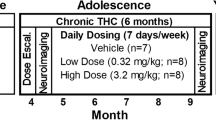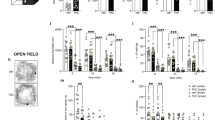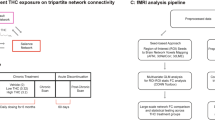Abstract
Among adolescents, the perception that cannabis can cause harm has decreased and use has increased. However, in rodents, cannabinoid administration during adolescence induces working memory (WM) deficits that are more severe than if the same exposure occurs during adulthood. As both object and spatial WM mature in a protracted manner, although apparently along different trajectories, adolescent cannabis users may be more susceptible to impairments in one type of WM. Here, we evaluate the acute effects of a range of doses (30–240 μg/kg) of intravenous Δ9-tetrahydrocannabinol (THC) administration on the performance of spatial and object WM tasks in adolescent rhesus monkeys. Accuracy on the object WM task was not significantly affected by any dose of THC. In contrast, THC administration impaired accuracy on the spatial WM task in a delay- and dose-dependent manner. Importantly, the THC-induced spatial WM deficits were not because of motor or motivational impairments. These data support the idea that immature cognitive functions are more sensitive to the acute effects of THC.
Similar content being viewed by others
Log in or create a free account to read this content
Gain free access to this article, as well as selected content from this journal and more on nature.com
or
References
Adams IB, Martin BR (1996). Cannabis: pharmacology and toxicology in animals and humans. Addiction 91: 1585–1614.
Agurell S, Halldin M, Lindgren JE, Ohlsson A, Widman M, Gillespie H et al. (1986). Pharmacokinetics and metabolism of delta 1-tetrahydrocannabinol and other cannabinoids with emphasis on man. Pharmacol Rev 38: 21–43.
Alexander GE (1982). Functional development of frontal association cortex in monkeys: behavioral and electrophysiological studies. Neurosciences Res Prog Bull 20: 471–479.
Alexander GE, Goldman PS (1978). Functional development of the dorsolateral prefrontal cortex: an analysis utilizing reversible cryogenic depression. Brain Res 143: 233–249.
Arseneault L, Cannon M, Poulton R, Murray R, Caspi A, Moffitt TE (2002). Cannabis use in adolescence and risk for adult psychosis: longitudinal prospective study. BMJ 325: 1212–1213.
Azorlosa JL, Heishman SJ, Stitzer ML, Mahaffey JM (1992). Marijuana smoking: effect of varying delta 9-tetrahydrocannabinol content and number of puffs. J Pharmacol Exp Ther 261: 114–122.
Cha YM, White AM, Kuhn CM, Wilson WA, Swartzwelder HS (2006). Differential effects of delta9-THC on learning in adolescent and adult rats. Pharmacol Biochem Behav 83: 448–455.
Chiang CN, Rapaka RS (1987). Pharmacokinetics and disposition of cannabinoids. Natl Inst Drug Abuse Res Monogr Ser 79: 173–188.
Conklin HM, Luciana M, Hooper CJ, Yarger RS (2007). Working memory performance in typically developing children and adolescents: behavioral evidence of protracted frontal lobe development. Dev Neuropsychol 31: 103–128.
Courtney SM, Ungerleider LG, Keil K, Haxby JV (1996). Object and spatial visual working memory activate separate neural systems in human cortex. Cereb Cortex 6: 39–49.
Crone EA, Wendelken C, Donohue S, van Leijenhorst L, Bunge SA (2006). Neurocognitive development of the ability to manipulate information in working memory. Proc Natl Acad Sci USA 103: 9315–9320.
Distler C, Bachevalier J, Kennedy C, Mishkin M, Ungerleider LG (1996). Functional development of the corticocortical pathway for motion analysis in the macaque monkey: a 14C-2-deoxyglucose study. Cereb Cortex 6: 184–195.
D’Souza DC, Perry E, MacDougall L, Ammerman Y, Cooper T, Wu YT et al. (2004). The psychotomimetic effects of intravenous delta-9-tetrahydrocannabinol in healthy individuals: implications for psychosis. Neuropsychopharmacology 29: 1558–1572.
Durston S, Davidson MC, Tottenham N, Galvan A, Spicer J, Fossella JA et al. (2006). A shift from diffuse to focal cortical activity with development. Dev Sci 9: 1–8.
Ehrenreich H, Rinn T, Kunert HJ, Moeller MR, Poser W, Schilling L et al. (1999). Specific attentional dysfunction in adults following early start of cannabis use. Psychopharmacology (Berl) 142: 295–301.
Funahashi S, Bruce CJ, Goldman-Rakic PS (1989). Mnemonic coding of visual space in the monkey’s dorsolateral prefrontal cortex. J Neurophysiol 61: 331–349.
Gogtay N, Giedd JN, Lusk L, Hayashi KM, Greenstein D, Vaituzis AC et al. (2004). Dynamic mapping of human cortical development during childhood through early adulthood. Proc Natl Acad Sci USA 101: 8174–8179.
Goldman PS, Alexander GE (1977). Maturation of prefrontal cortex in the monkey revealed by local reversible cryogenic depression. Nature 267: 613–615.
Goldman PS, Rosvold HE (1970). Localization of function within the dorsolateral prefrontal cortex of the rhesus monkey. Exp Neurol 27: 291–304.
Goldman PS, Rosvold HE, Vest B, Galkin TW (1971). Analysis of the delayed-alternation deficit produced by dorsolateral prefrontal lesions in the rhesus monkey. J Comp Physiol Psychol 77: 212–220.
Hampson RE, Deadwyler SA (1999). Cannabinoids, hippocampal function and memory. Life Sci 65: 715–723.
Heyser CJ, Hampson RE, Deadwyler SA (1993). Effects of delta-9-tetrahydrocannabinol on delayed match to sample performance in rats: alterations in short-term memory associated with changes in task specific firing of hippocampal cells. J Pharmacol Exp Ther 264: 294–307.
Jentsch JD, Andrusiak E, Tran A, Bowers Jr MB, Roth RH (1997). Delta 9-tetrahydrocannabinol increases prefrontal cortical catecholaminergic utilization and impairs spatial working memory in the rat: blockade of dopaminergic effects with HA966. Neuropsychopharmacology 16: 426–432.
Johansson E, Halldin MM (1989). Urinary excretion half-life of delta 1-tetrahydrocannabinol-7-oic acid in heavy marijuana users after smoking. J Anal Toxicol 13: 218–223.
Jones B, Mishkin M (1972). Limbic lesions and the problem of stimulus--reinforcement associations. Exp Neurol 36: 362–377.
Justinova Z, Tanda G, Redhi GH, Goldberg SR (2003). Self-administration of delta9-tetrahydrocannabinol (THC) by drug naive squirrel monkeys. Psychopharmacology (Berl) 169: 135–140.
Kwon H, Reiss AL, Menon V (2002). Neural basis of protracted developmental changes in visuo-spatial working memory. Proc Natl Acad Sci USA 99: 13336–13341.
Lane SD, Cherek DR, Lieving LM, Tcheremissine OV (2005). Marijuana effects on human forgetting functions. J Exp Anal Behav 83: 67–83.
Lewis DA (1997). Development of the primate prefrontal cortex. In: MS Keshavan, RM Murray (eds). Neurodevelopment & Adult Psychopathology. Cambridge University Press: Cambridge. pp 12–30.
Lindgren JE, Ohlsson A, Agurell S, Hollister L, Gillespie H (1981). Clinical effects and plasma levels of delta 9-tetrahydrocannabinol (delta 9-THC) in heavy and light users of cannabis. Psychopharmacology (Berl) 74: 208–212.
Luna B, Padmanabhan A, O’Hearn K (2010). What has fMRI told us about the development of cognitive control through adolescence? Brain Cogn 72: 101–113.
Mishkin M, Manning FJ (1978). Non-spatial memory after selective prefrontal lesions in monkeys. Brain Res 143: 313–323.
Moore TH, Zammit S, Lingford-Hughes A, Barnes TR, Jones PB, Burke M et al. (2007). Cannabis use and risk of psychotic or affective mental health outcomes: a systematic review. Lancet 370: 319–328.
Murray EA, Wise SP (2010). What, if anything, can monkeys tell us about human amnesia when they can’t say anything at all? Neuropsychologia 48: 2385–2405.
Ohlsson A, Lindgren JE, Wahlen A, Agurell S, Hollister LE, Gillespie HK (1980). Plasma delta-9 tetrahydrocannabinol concentrations and clinical effects after oral and intravenous administration and smoking. Clin Pharmacol Ther 28: 409–416.
Paule MG, Bailey JR, Fogle CM, Gillam MP, Slikker Jr W, Brown RM (1987). Plasma distribution of delta-9-tetrahydrocannabinol (THC) in the rhesus monkey after marijuana smoke exposure. Proc West Pharmacol Soc 30: 397–399.
Pope Jr HG, Gruber AJ, Hudson JI, Cohane G, Huestis MA, Yurgelun-Todd D (2003). Early-onset cannabis use and cognitive deficits: what is the nature of the association? Drug Alcohol Depend 69: 303–310.
Quinn HR, Matsumoto I, Callaghan PD, Long LE, Arnold JC, Gunasekaran N et al. (2008). Adolescent rats find repeated Delta(9)-THC less aversive than adult rats but display greater residual cognitive deficits and changes in hippocampal protein expression following exposure. Neuropsychopharmacology 33: 1113–1126.
Rainer G, Asaad WF, Miller EK (1998). Selective representation of relevant information by neurons in the primate prefrontal cortex. Nature 393: 577–579.
Ranganathan M, D’Souza DC (2006). The acute effects of cannabinoids on memory in humans: a review. Psychopharmacology 188: 425–444.
Reiss AL, Abrams MT, Singer HS, Ross JL, Denckla MB (1996). Brain development, gender and IQ in children. A volumetric imaging study. Brain 119: 1763–1774.
Schulze GE, McMillan DE, Bailey JR, Scallet A, Ali SF, Slikker Jr W et al. (1988). Acute effects of delta-9-tetrahydrocannabinol in rhesus monkeys as measured by performance in a battery of complex operant tests. J Pharmacol Exp Ther 245: 178–186.
Schulze GE, McMillan DE, Bailey JR, Scallet AC, Ali SF, Slikker Jr W et al. (1989). Acute effects of marijuana smoke on complex operant behavior in rhesus monkeys. Life Sci 45: 465–475.
Schweinsburg AD, Brown SA, Tapert SF (2008). The influence of marijuana use on neurocognitive functioning in adolescents. Curr Drug Abuse Rev 1: 99–111.
Slikker Jr W, Paule MG, Ali SF, Scallet AC, Bailey JR (1991). Chronic marijuana smoke exposure in the rhesus monkey I. Plasma cannabinoid and blood carboxyhemoglobin concentrations and clinical chemistry parameters. Fundam Appl Toxicol 17: 321–334.
Substance Abuse and Mental Health Services Administration (2010). Results from the 2009 National Survey on Drug Use and Health: Volume II. Technical Appendices and Selected Prevalence Tables (Office of Applied Studies, NSDUH Series H-38B, HHS Publication No. SMA 10-4856Appendices) Rockville, MD.
Tamm L, Menon V, Reiss AL (2002). Maturation of brain function associated with response inhibition. J Am Acad Child Adolesc Psychiatry 41: 1231–1238.
Tanda G, Munzar P, Goldberg SR (2000). Self-administration behavior is maintained by the psychoactive ingredient of marijuana in squirrel monkeys. Nat Neurosci 3: 1073–1074.
Vadhan NP, Serper MR, Haney M (2009). Effects of delta-THC on working memory: implications for schizophrenia? Prim psychiatry 16: 51–99.
Varvel SA, Hamm RJ, Martin BR, Lichtman AH (2001). Differential effects of delta 9-THC on spatial reference and working memory in mice. Psychopharmacology (Berl) 157: 142–150.
Verrico CD, Jentsch JD, Roth RH, Taylor JR (2004). Repeated, intermittent delta(9)-tetrahydrocannabinol administration to rats impairs acquisition and performance of a test of visuospatial divided attention. Neuropsychopharmacology 29: 522–529.
Verrico CD, Liu S, Asafu-Adjei JK, Sampson AR, Bradberry CW, Lewis DA (2011). Acquisition and baseline performance of working memory tasks by adolescent rhesus monkeys. Brain Res 1378: 91–104.
Volkow ND, Gillespie H, Mullani N, Tancredi L, Grant C, Valentine A et al. (1996). Brain glucose metabolism in chronic marijuana users at baseline and during marijuana intoxication. Psychiatry Res 67: 29–38.
Watts ES, Gavan JA (1982). Postnatal growth of nonhuman primates: the problem of the adolescent spurt. Hum Biol 54: 53–70.
Wilson FA, Scalaidhe SP, Goldman-Rakic PS (1993). Dissociation of object and spatial processing domains in primate prefrontal cortex. Science 260: 1955–1958.
Wilson W, Mathew R, Turkington T, Hawk T, Coleman RE, Provenzale J (2000). Brain morphological changes and early marijuana use: a magnetic resonance and positron emission tomography study. J Addict Dis 19: 1–22.
Wojnicki FH, Bacher JD, Glowa JR (1994). Use of subcutaneous vascular access ports in rhesus monkeys. Lab Anim Sci 44: 491–494.
Yurgelun-Todd D (2007). Emotional and cognitive changes during adolescence. Curr Opin Neurobiol 17: 251–257.
Acknowledgements
We are grateful to Lisa Nieman-Vento and Melanie Peterson for excellent technical support. The authors declare that this project was funded by Award Number DA023109 from the National Institute of Mental Health and a NARSAD Distinguished Investigator award (DAL).
Author information
Authors and Affiliations
Corresponding author
Ethics declarations
Competing interests
The authors declare that over the past 3 years CDV has received compensation from the American Physiological Society; ARS has received compensation from Johnson and Johnson Pharmaceutical Research and Development LLC and Winston Laboratories, and DAL has received research support from the BMS Foundation, Bristol-Myers Squibb, Curridium, and Pfizer and served as a consultant in the areas of target identification and validation and new compound development to BioLine RX, Bristol-Myers Squibb, Merck, and SK Life Science.
Additional information
Disclaimer
The content is solely the responsibility of the authors and does not necessarily represent the official views of the National Institute of Mental Health or the National Institutes of Health.
Supplementary Information accompanies the paper on the Neuropsychopharmacology website
Supplementary information
Rights and permissions
About this article
Cite this article
Verrico, C., Liu, S., Bitler, E. et al. Delay- and Dose-Dependent Effects of Δ9-Tetrahydrocannabinol Administration on Spatial and Object Working Memory Tasks in Adolescent Rhesus Monkeys. Neuropsychopharmacol 37, 1357–1366 (2012). https://doi.org/10.1038/npp.2011.321
Received:
Revised:
Accepted:
Published:
Issue date:
DOI: https://doi.org/10.1038/npp.2011.321
Keywords
This article is cited by
-
Repeated Δ-9-Tetrahydrocannabinol administration dose dependently increases stablished schedule-induced drinking
Psychopharmacology (2024)
-
The Use of Touchscreen-Based Methods to Characterize Effects of Psychoactive Drugs on Executive Function in Nonhuman Primates
Current Pharmacology Reports (2023)
-
Effects of Adolescent Cannabinoid Self-Administration in Rats on Addiction-Related Behaviors and Working Memory
Neuropsychopharmacology (2017)
-
Are adolescents more vulnerable to the harmful effects of cannabis than adults? A placebo-controlled study in human males
Translational Psychiatry (2016)
-
Persistent effects of chronic Δ9-THC exposure on motor impulsivity in rats
Psychopharmacology (2015)



